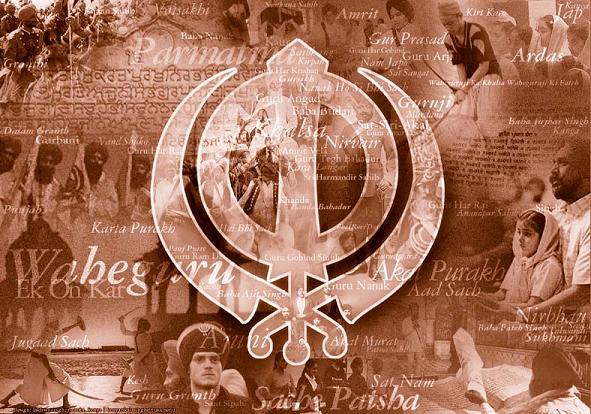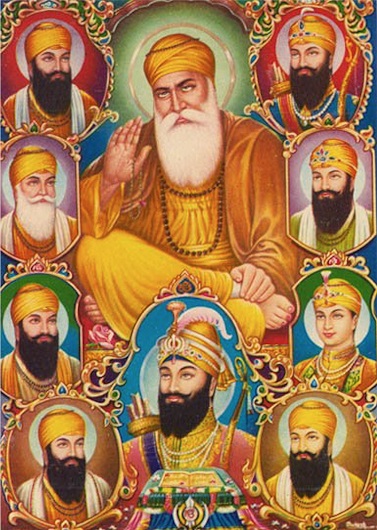
Mai Bhag Kaur
Dr. Kulwant Singh Khokhar

Mai Bhag Kaur
Mai Bhag Kaur, popularly known as Mai Bhago, was born in village Jhabal, near Amritsar. She was the granddaughter of Bhai Paro Shah, brother of Bhai Langaha, who served Guru Arjan Dev and Guru Har Gobind Ji.
As a young girl, she heard the sakhis of the martyrdom of Guru Arjan Dev and of army attacks on Guru Har Gobind. State terrorism against the Gurus and the Sikhs was often talked about in the family. Her two generations were closely involved with it because they had personally experienced it while serving the Gurus. A regular hearing of the sakhis of injustices done to the Sikhs and their harassment by the police and army made a deep effect on her tender heart.
Mai Bhago was still a child when she heard sakhis of Guru Tegh Bahadur and three Sikhs, Bhai Dayala, Bhai Mati Das and Bhai Sati Das who were tortured and murdered at Delhi in 1675. The sad news touched her heart and she decided in her mind to do her duty to stop such state violence against the Sikhs. This thought grew stronger and stronger in her mind as she grew into her teens.
She went to Anandpur Sahib along with her father in 1699 when Guru Gobind Singh founded the Khalsa Panth. She took Amrit and wanted to stay there to learn the art of fighting and self defense. But, her father brought her to their village because she was a woman and not a man to go to the fighting lines. In her mind, however, she continued to nurse the idea of joining the Khalsa forces.
After returning to her village, she started learning martial arts, particularly the use of the spear. She would go to a nearby forest reserve and practice piercing trees with her spear. She soon became an expert in the art of using this handy weapon in battle.
Government forces surrounded Anandpur in 1704 but they could not defeat the Guru or make him vacate the city. Finally to save their face with the emperor, they under a written oath, requested the Guru to leave Anandpur without being harmed by them. They agreed not only to let the Guru move out of Anandpur to anywhere he liked to go, but also to let him come and stay at Anandpur again after some time. They wrote to the Guru that their only aim was to make the Guru leave Anandpur at that time and that they had no intention of harming the Guru.
The generals, however, broke their oath and attacked the Guru when he came out of the fort. He was forced to fight battles while crossing the river Sirsa and at a nearby village Chamkaur where many of his Sikhs and his two elder sons became martyrs. They, however, could not harm the person of the Guru.
The news that the Guru had left Anandpur and was coming to Malwa made Mai Bhago do what she was thinking long since. She went from village to village to inform the Sikhs and organize them to challenge the army following the Guru. While addressing people in a village she would tell them, "Our Guru has sacrificed all his family for our freedom. Why can't we ourselves stand up and protect our own civil and human rights?" Her sharp words awakened the souls of many men. They would wonder at the bravery of a woman going around courageously and making people get together for claiming their rights and fighting for justice.
Mai Bhag Kaur and hundreds of men with her were planning their strategy when the news came that the Guru was proceeding towards Khidrana Di Dhab, the lake now called Mukatsar, and the Mughal Army was following him. They decided to check the army from reaching the lake, the only source of water for many miles around. The Guru with some Sikhs occupied the top of the mound on the bank of the lake. Mai Bhag Kaur and the Sikhs with her organized themselves around the lake.
When the army arrived at the lake and attacked the Sikhs, they were ready to beat them back. A bloody battle took place. Mai showed her bravery by fighting with the soldiers in the front lines. She would use her spear with a smart move. Before a soldier could get ready to attack her, he was down on the earth with his chest pierced by her spear. The mercenary soldiers could not face the devoted Sikhs. The Guru from the mound provided the necessary support with his snake-like arrows. The army generals soon found that unless they retreated quickly all of them would find their graveyard in the battlefield and none would return alive. Historians say that they left even their wounded soldiers unattended and returned as fast as they could. This was the last battle the Mughal army could dare to fight with the Guru.
After the battle was won, the Guru came down from the mound and took care of the wounded and the dead. Mai Bhag Kaur was lying badly injured. She was treated carefully and she soon became healthy. When the Guru asked her to go back to her village along with other Sikhs, she told the Guru her long cherished desire to become an active saint-soldier in the army of the Guru. Her wishes were granted and the Guru agreed to let her stay with him as a member of his bodyguard.
Along with the Guru, she went to Nanded in the south of India and lived there for the rest of her life. There is a Gurdwara where she lived at Nanded, near the Gurdwara Sachkand built in memory of the Guru. It reminds the visitors of her devotion and services to the Guru.
Like Sikh men, Sikh women are equally good saint-soldiers. They can organize men and lead them to fight and win battles for the freedom of people and their human rights.

